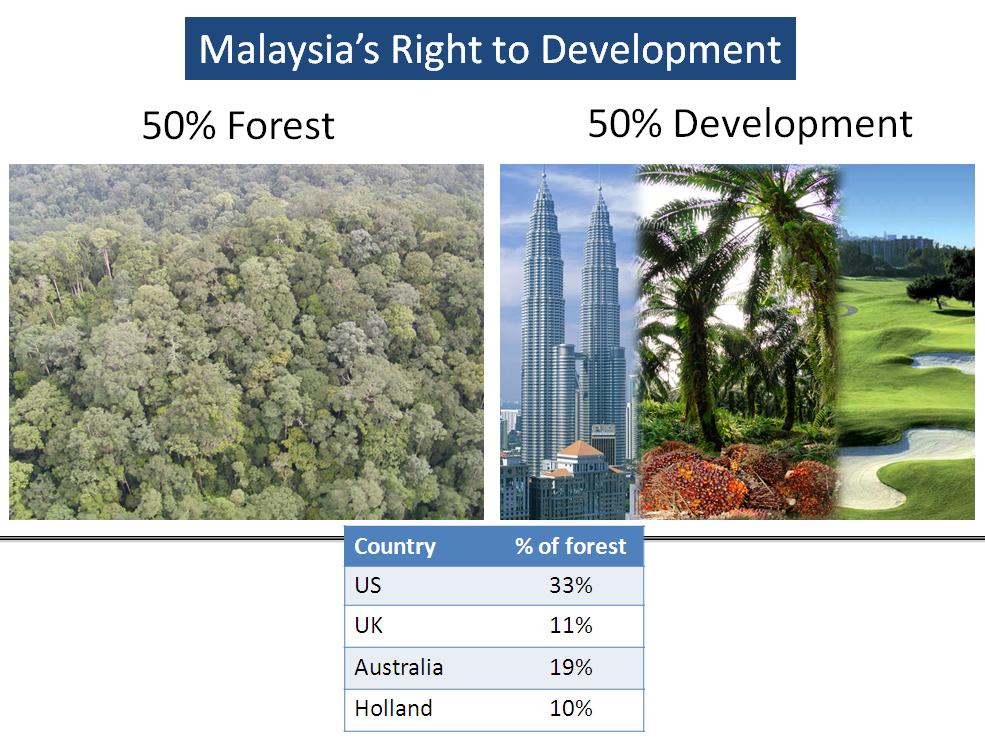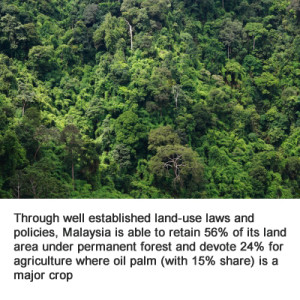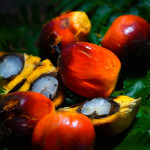Countries at a Disadvantage for Maintaining Large Forest Cover
Palm oil continues to be in demand in all world regional markets despite the active campaigns by green western NGOs to cast negative aspersions on the commodity. Perhaps, consumers have become doubtful of the information propagated by the green western NGOs.
These NGOs are good at deceiving others by creating wrong perceptions and often reporting on negative elements, by backing their statements with the phrase “It was reported…”. As to who reported it or whether there was a police report lodged over any wrong doing remains doubtful. Allegations like killing of 300 orang utans or removing 300 football fields per minute of protected forests are portrayed as serious breaches of the country’s laws. If 300 orang utans are indeed killed, then surely there should be strong evidence to support this claim. One cannot hide the killing of 300 orang utans!
Allegations hurled against Malaysia are often not true. Conservation laws and policies have long been in place . The country’s track record in environmental conservation goes back to 1976 when, under the Third Malaysia Plan, the Government established 15 conservation areas in excess of 5,600 sq km. This was only the start of its commitment.
At the 1992 Rio Earth Summit, Malaysia pledged to preserve 50% of its forests – and has exceeded its own target, with 56% forest cover currently. It clearly demonstrates that 20 years on, Malaysia is unwavering in its stance on environmental conservation and biodiversity. The significance of this cannot be under-estimated, given that nations are only required to keep 10% of land for biodiversity.
Any clearing of protected forest in Malaysia for planting oil palm is considered an offence. The Ministry of Natural Resources and Environment (NRE) will immediately haul up the company and the Malaysian Palm Oil Board (MPOB) will not hesitate to revoke its license.
Constant use of the phrase “It was reported…” lacks credibility. Even the media becomes weary of such claims as evidence based reporting is necessary. It becomes clear that the NGOs refer to their own NGO networks as a source of information for their reports. Hence, the standard phrase “It was reported” is the main tool used by the detractors to deceive the public.
Exaggeration is also often used as a tool to deceive readers. Malaysian oil palm plantations occupy only 0.1 % of the world agricultural land area. Even if we double the country’s oil palm cultivation, the increase is insignificant to impact the world’s carbon emission assuming, there are emissions.
Carbon accounting reports submitted by Malaysia to UNFCC revealed that the oil palm has greater CO2 removal capacity than its emission potential. Small oil palm farmers with a few hectares of planted area have been farming for a much longer period as compared to their counterparts involved in soybean or rapeseed cultivation. Instead, the oil palm farmers are penalized by the EU Renewable Energy Directive (RED) and by the US Environmental Protection Agency (EPA) as they claim that palm oil does not meet the minimum lifecycle greenhouse gas (GHG) reduction threshold to qualify as renewable fuel.
Modeling studies with various assumptions are also often used as an approach to deceive the public. This was notoriously used by the EPA to justify its preliminary results to claim that palm bio-diesel only contributes 11-17% emissions–savings compared to fossil fuels, much lower than the 20% GHG reduction threshold to qualify as a renewable fuel under the US RFS programme. No doubt, there are those who support the results in the EPA modeling simulation although the reliability and accuracy is highly doubtful.
Both the EU RED and US RFS programme feeds off the misconceptions espoused by ENGOs. Amongst them, the “Union of Concerned Scientists” has become a mouthpiece of NGOs in US. They were actively running side events at the Durban Climate Change Conference last year and have been increasingly opposing palm oil. In a joint report submitted to the EPA commenting on the emissions value for palm biodiesel, they proposed that the emission figures be increased, making them the ultra opposition group to the palm oil industry. They are opposed to the small farmers who produce 40 % of the world palm oil.
What surprises many is that the submission against palm oil is also supported by amongst others, WWF, the founding member of the Roundtable for Sustainable Palm Oil (RSPO) and an active campaigner for Certified Sustainable Palm Oil (CSPO) production in Malaysia and Indonesia. It’s ironic that, on one hand WWF claims to be working for the betterment of the palm oil industry through RSPO, while on the other, it opposes the industry at international debates such as the aborted palm oil labeling proposal in Australia and the ill-conceived emissions saving figures of the EPA. This sends distorted signals to countries like Malaysia and Indonesia who have openly embraced the concept of RSPO based on trust and a win win situation for all. Although funding could be their motivation, to the oil palm small farmers, the dual roles played by WWF as a supporter and opposer only jeopardizes the market access for palm oil and affects their livelihood severely through low prices and reduced income. This basically denies the palm oil farmer to produce and market his product in a free market. These senseless negative impacts on the already poor oil palm farmers as a result of NGOs opposition to the growing palm oil industry is unfair and will further push the farmers into extreme poverty.
It’s obvious that smear tactics are often selectively applied to competing products like palm oil. Farmers producing other competing crops do not face similar adversities from the NGOs, even though they cultivate much larger land area and incur higher carbon foot print. After all, palm oil uses significantly less land per hectare than any competing vegetable oil, including canola, rapeseed and soybean oils. No competing oil comes close to the oil palm’s yield.
The arguments championed by NGOs are not helping to improve deforestation rates or global emissions. The US will continue to emit 7 billion tonnes of CO2 equivalent(eq) per year. Malaysia which is one of the largest producers of palm oil only emits less than 50 million tonnes CO2 eq per year due to the burning of fossil fuel for the energy sector. Oil palm is a carbon sink, showing superior qualities in locking up and removing more carbon from the atmosphere than it produces.
In Malaysia, land use and planning has been efficiently and judiciously managed over a long period of time. It has resulted in land being put to use properly for development, agriculture and forestry. The allocation of land for these purposes is gazetted and legally enforced throughout the tenure of land use. Oil palms in Malaysia are therefore cultivated legally on legally allocated agriculture lands. In this regard, it shares the same legal credentials as other crops such as rubber, coffee, rice, soya, rapeseed and canola grown on agricultural land. The MPOB manages the licensing, registration and regulation of oil palm growers, millers, refiners, processors, traders and suppliers throughout and across the palm oil supply chain. Such efforts carried out over decades have ensured that the industry is well regulated.

Malaysia pledged two decades ago at the Rio Earth Summit to set aside 50% of land as forest. The remaining 50% is used for development of cities, towns, villages, industrial parks and planting of agricultural crops. Therefore, oil palm is an agricultural crop planted on land set aside for development of agriculture. These areas include idle land abandoned due to non-viability of crops such as rice, rubber, cocoa and coconuts where farmers have now planted oil palm as a viable cash crop. Oil palm cultivation therefore did not replace forest land as permanent forest has been gazetted by an Act of Parliament and cannot be used for conversion to other uses. Under the present policy, the non forested zone is simply defined for national development use while the rest remains as permanent forest.
Malaysia’s agricultural contribution to GDP has shrunk from 15% in the 80’s to just 8% presently due to industrialization and migration of youth to cities where the urban population has grown to 60%. To remain sustainable, it may be prudent for developing countries to redefine sustainability in line with the current trend of maintaining forest in developed countries. Three countries are used here as an example to compare forest areas; US (33%), Australia (19%) and UK (11%). Based on these three figures, a good model to follow is the US where 33% of the country’s land area is considered sufficient to maintain as forest.
Like any developing nation, Malaysia faces constant population pressure to generate more income and employment. Therefore, the 56% forest area is non-sustainable. Forest earns 30 times less revenue compared to agricultural land. If Malaysia aspires to be a developed country, it has to follow other developed countries by reducing its forest to a more sustainable ratio such as 33%. It gets no reward or compensation for maintaining more than 50% of its land as forest. Such moves hamper the country’s effort to become a developed nation as it is not able to unlock its national land assets as practiced by other developed countries.
The NGOs who pressure developing countries to keep their forest are certainly not reflecting the need for a sustainable development. NGOs after all have to generate income to support their cause therefore, their motive is mainly income generation which is further supported by their role as a voice of competitors or supporting the protectionist agenda of developed countries to prevent competition and free trade. The use of land for oil palm cultivation in Malaysia is insignificant. For example, the land area occupied by oil palm plantations in Malaysia is less than 0.1% of the total agricultural area globally. Within the country, oil palm occupies 15% of the total land area as compared with 55 % forest, indicating a prudent policy by Malaysia to keep its forest and forego an opportunity to earn a higher income from a more sustainable agricultural development. In comparison, Australia has continued to deforest at 3 to 5 times the rate in Malaysia in the last 10 years to optimize land use even though they have only 19% of the total country area as forest.
Forest and agricultural land use is reversible. If Western NGOs demand for more forest, they should lobby their own governments to regenerate forest and reduce their agricultural areas. The area around Chernobyl which was evacuated due to a nuclear plant meltdown has now become a forest complete with wildlife. This shows that abandon land can regenerate into forest. Assisting the process by planting trees will accelerate such reforestation.
Due to the reversibility of land use, most countries can have the optimum % of forest. Malaysia should follow the example set by developed countries by having a similar percentage of forest as US. (33%). Developed countries cannot afford to have 55% of their country as forest as this would not be sustainable.
NGOs have devised arguments for developing countries not to follow the developed countries in deforestation. This will create a non-level playing field. Development in the developed countries took place much earlier and optimal deforestation rates have occurred. Otherwise the ideal percentage would be considered in their land use policy. For some countries like Australia and Canada, deforestation continues to occur. In Germany, reforestation has already begun. Overall, it can be argued that the optimal percentage is 33% as per in the US. If this rate has served the US well it should also be adopted by others. The current forest ratio of 55% is clearly not sustainable for a country that aspires to reach a developed nation status.
For those who disagree, two options can be made available. Compensate developing countries such as Malaysia and Indonesia who maintain a high percentage of their land as forest above the standard set by developed countries, or urge developed countries to have more forest by carrying out reforestation of over exploited land. This helps to create balance in both the current debate and in the development process of countries.
As shown, in the previous blog article, planting oil palm on our agricultural land is having a net effect of converting our agricultural land to act as a planted forest. Even though it occupies less than 0.1% of global agricultural area, it remains a net carbon sink.
In conclusion, the oil palm industry in Malaysia is a negligible user of agricultural land, and is not the cause of deforestation as the crop has been cultivated on land set aside for development and agriculture purposes. 55% of the land area of the country remains as forest. In reviewing the standards set by developed countries, Malaysia has provided more forest cover compared to many other developed countries. Such self inflicted disadvantage will lead to unsustainable growth and development in view of an increasing national and global population.










UE and US like to criticize but the missed all the time to look inside their own yard!
More the that, the palm agriculture, means to plant trees and not plants.
Malaysia is increasing its forest surfaces by practicing the palm tree agriculture.
On some European countries, the peoples believes that for making the palm oil, the trees are cut! 🙂
The ignorance and lack of information is always speculated by the bad intended persons.
What a very informative site, I have found alot of very useful information here and still have a lot more to read. Thank you very much for the time and effort you have put in….
http://www.KneeNeckBackPain.com/